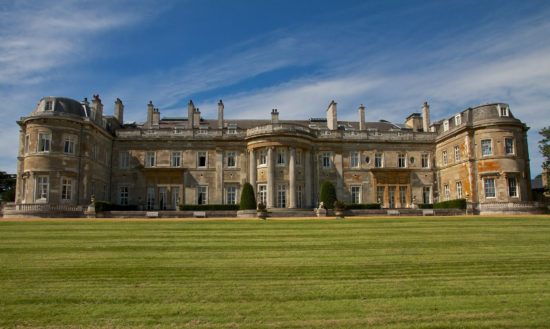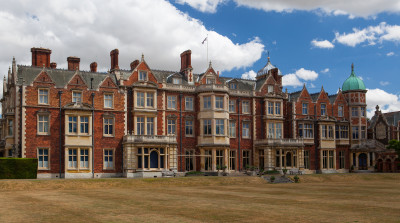Nonsuch Palace was perhaps Henry VIII’s greatest architectural achievement, and yet few people know about one of the most stunning Tudor Palaces since it no longer stands today.
Located near Epsom and Ewell, the palace was created in 1538 to rival the French King’s Château de Chambord. Henry VIII and Francis I had had a rivalry which swayed between friendly and war-waging with the change of the seasons, and the statement such a manor would bring was the best kind of Tudor propaganda.

A model of Nonsuch Palace, perhaps Henry VIII’s greatest palace, from the south side (Friends of Nonsuch/ Dr.J.Crook FSA)
Rather an unusual name, Nonsuch was so-called as the plans were so grand, no other house could rival it. Also different about Nonsuch, was that it was not an upgrades or extension of an existing building. Henry specifically wanted this palace to be his own design, a true expression of Tudor might and power. Henry wanted a palatial hunting retreat to add to his collection of 13 palaces in and around the capital. Despite its size – over 900 ft long, with an average height of 24 ft – this was actually a smaller residence, made for the King and his intimates.
More than £24,000 (£104 million in 2009) was spent on the creation of Nonsuch, due to the intricate detail and ornamentation; the palace is still considered a key work in the introduction of elements of Renaissance design to England.

Francis I’s Château de Chambord. Henry VIII built Nonsuch Palace to rival it (Thomas Conte)
Around 500 workmen from across Europe were brought to Nonsuch, for their expertise. It was covered with carved and gilded sheets of slate known to be the work of Nicholas Bellin of Modena, who had worked at Fontainebleau.

A model of Nonsuch Palace shows the rich decoration of the south facade, with its octagonal towers (Roger Poynter)
The basic floor plan was an outer and inner courtyard, each with a fortified gatehouse. The northern side was a more medieval-style fortification, similar to the look of Hampton Court, while the southern facade held the ornate Renaissance decoration, with octagonal towers at the corners.
It had a Kings side and a Queens side, each with fountains, statues and carvings. Three tiers of plaster sculptures adorned the walls, and 30 three-quarter life-size sculptures of Roman emperors framed in carved and gilded slate panels sat at the far end of the inner courtyard. Sitting proudly in the middle, was a statue of Henry and his longed-for son, Edward VI.

Hoefnagel regarded it as one of the wonders of the world, and so took his paints and easel, creating his famous watercolour of Nonsuch.
The palace was not finished by Henry’s death on 27th January 1547, and the King is recorded to have visited just thrice: twice in 1545 and once in 1547.

Edward inherited Nonsuch upon his father’s death, but neither he, nor his sister Mary, had much affection for the residence. The first Queen Regnant of England sold the palace to Henry Fitzalan, Earl of Arundel in 1556. Arundel bore fruit to Henry’s vision for Nonsuch, completing the works in 1559.
Fizalan’s son actually resold the Palace to Elizabeth I, who used it regularly for hunting, spending time there each summer. Nonsuch then remained in Royal possession for roughly a century: James I gave the palace to his wife Anne of Denmark, and Charles I also gifted Nonsuch to his Queen, Henrietta Maria. During the Interregnum under Cromwell, a 1650 survey noted that the palace was already in need of expensive repairs.

The northern facade of Nonsuch was less detailed and more traditional in style (Wikimedia Commons)
It was after his mother’s death that Charles II gave the palace to one of his mistresses, Barbara Villiers. Deciding that her grand residence costed too much (and with a stack of gambling debts, not unusual for the Caroline court) Villiers demolished the building in 1682, and much of the stone and decoration ended up in the surrounding areas.
In 2009, Professor Martin Biddle and Ben Taggart cooperated to recreate Nonsuch in model form. Taking 1250 hours to complete, the replica is based upon contemporary illustrations and archaeological evidence. The likeness was created from wood with architectural details added in various plastics, fibre-glass resin and brass, including almost 150 ‘stucco panels’.
Prof Biddle said at the time: “From the start it was Henry’s evident intention to celebrate the birth of long awaited male heir by building a house without equal.”
“With the plan established, it is possible to attempt to accurately evaluate what the house looked like in its heyday.”

Biddle, an Emeritus Professor of Medieval Archaeology at Oxford, was an undergraduate when he directed the excavation of the site of the palace in 1959. The search for Nonsuch and discovery of its foundations generated a lot of interest in archaeology thanks to the press coverage of the time; it also sparked a new era of digging for and resarching medieval buildings.
Little could be found on the internal structure of Nonsuch, so we do not know the scale of the grandeur inside, and what sort of lifestyle Henry expected from his masterpiece.
The Friends of Nonsuch now run the site, including a gallery of Nonsuch in the mansion house on the site.






